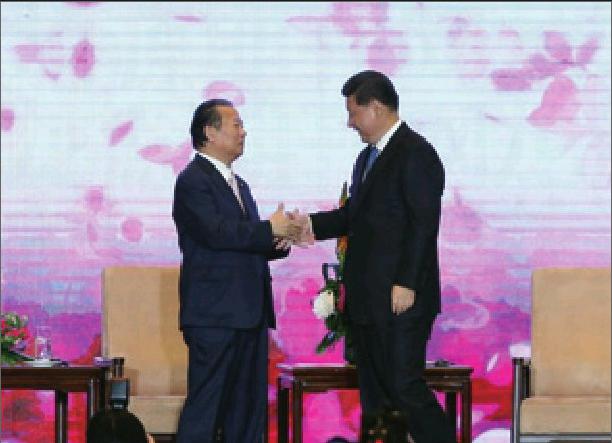Mending Ties
2015-06-05ByZengWenhui
By+Zeng+Wenhui


A Japanese delegation headed by Toshihiro Nikai, Chairman of the Liberal Democratic Party of Japans General Council, made a one-week tour around China beginning May 20. The delegation was made up of heads of local governments and enterprises from the 47 prefectures of Japan. The 3,000-member delegation visited Beijing, Tianjin, Shanghai and other places in separate groups.
Zhao Gang, associate researcher at the Institute of Japanese Studies of the Chinese Academy of Social Sciences, said, “The delegation is the largest in terms of scale during Shinzo Abes tenure as Prime Minister. The visit shows that after undergoing the worst period in bilateral relations since the normalization of diplomatic ties between the two sides in 1972, Sino-Japanese relations have eased after meetings between President Xi Jinping and Abe since last year.”
Wang Taiping, Deputy Director of the 21st Century Committee for China-Japan Friendship told Beijing Review that Japanese citizens have been very active in signing up for the delegation.
“I think this is exciting. It shows Japanese people are willing to carry out exchanges with their Chinese counterparts to promote understanding,” said Wang.
Chinese President Xi Jinping attended the gathering of the delegation in Beijing on May 23 when he received a letter penned by Japanese Prime Minister Shinzo Abe. President Xi talked to Nikai for about 10 minutes. “The China-Japan friendship is rooted in the people, and the future of the bilateral relationship is in the hands of the people of the two countries,” President Xi said.
According to the Japanese daily newspaper Sankei Shimbun, Nikai said at a press conference that he called Abe and told him that President Xi attended the gathering and delivered a speech and that Abe was very happy about it.
Japans another daily Yomiuri Shimbun said that it is rare for Chinese leaders to have face-to-face dialogue with the delegation. It shows Chinas willingness to thaw relations with Japan.
Peace and friendship are shared values of the peoples of the two countries.
Liu Jiangyong, Vice Dean of Institute of Modern International Relations of Tsinghua University, told Beijing Review that this year marks the 70th anniversary of the end of World War II. It is time to look back and reflect upon history and to look forward to the future. Only by adopting an objective view of history can the two countries be able to enjoy sustained peace and friendship in the future. The visit by the Japanese delegation is a clear manifestation of this mission.
Toshihiro Nikai is widely recognized as a pro-China figure in the Japanese political field. He organized a 5,000-member and a 13,000-member delegation to visit China in 2000 and 2002 respectively. During the latter visit, the delegation planted 13,000 trees near the Badaling section of the Great Wall in suburban Beijing to commemorate SinoJapanese friendship.
Zhao said the size of the delegation could be thought of as a gauge of ChinaJapan relations. The number of participants this time round demonstrates that Japanese people are concerned about deteriorating bilateral ties.
Fostering understanding
Liu said that China-Japan relations have been deteriorating due to territorial disputes sur-rounding the Diaoyu Islands and incumbent Japanese leaders flawed views toward WWII history. Diplomatic ties inevitably have an influence on the two peoples opinions of each other.
Liu suggests that the two peoples should directly communicate with each other, rather than being swayed by any biased views.
The visit will help improve mutual understanding, in particular, Japanese peoples understanding of China. It will also help to mitigate antagonistic sentiments between the two peoples, said Zhao.
The delegation has not only visited tourist destinations but also observed locations in the process of development, hopefully leaving an impression of China as an open, inclusive and friendly nation. The photos and impressions they take home with them to their families and friends can give a better, more accurate picture of their neighbor.“China welcomes every guest,” said Liu.
Wang suggested China and Japan increase tourism and exchanges in order to counter misunderstandings, revisit their shared cultural roots and establish a sense of fellowship.
However, Liu noted that this nongovernmental delegation cannot solve the thorny issues between the two countries by itself because they do not represent Japanese Government.
“We welcome the Japanese delegation, however, this doesnt mean that we will waver on historical and territorial issues,” said Liu. “We will never change our stance and in the meantime we should recognize that the words and deeds of some Japanese leaders dont express the views of their people.”
Tourism and trade
The tourism industries of China and Japan have a promising prospect. Liu said that as Japan has loosened the approval requirements for visa issuance and the value of the Japanese yen has depreciated significantly against the Chinese yuan as a result of Japans quantitative easing policy, Chinese tourists to Japan have increased considerably in recent years, becoming an important source of consumption in Japan.
The visit presented a good opportunity for the tourism sector in China to better meet the needs of visitors,” said Liu.
Since September 2013, the number of Chinese tourists visiting Japan has begun to rebound and now frequently sets new records. Conversely, the number of Japanese tourists to China has been plummeting. Part of the reason for this is that the appreciation of the yuan against the Japanese yen increases the cost for Japanese visitors. Negative coverage of China by certain Japanese media outlets and insufficient infrastructure such as hotels near tourist des- tinations in China have also contributed to the drop in Japanese tourists.
“It is expected that the visit will serve to boost tourism in both directions and promote cultural exchanges between the two countries,” said Wang.
Trade between China and Japan has been decreasing since the Japanese decision to “purchase” Chinas Diaoyu Islands back in 2012, where it dropped 3.3 percent compared to 2011. In 2013, it shrank by a further 6.5 percent year on year, though 2014 saw a year-on-year reduction of only 1 percent—possibly indicating a light at the end of the tunnel.
Zhao said besides influence from ChinaJapan relations, the industrial restructuring of China has also contributed to the decrease in bilateral trade. Previously, China mainly exported raw materials or minimally processed products that are complementary to major Japanese industries. However, with Chinas industrial restructuring, competition begins to grow between the two.
“In spite of competition on the economic and trade fronts, these friendly exchanges will help boost trade between the two countries,” said Zhao.
